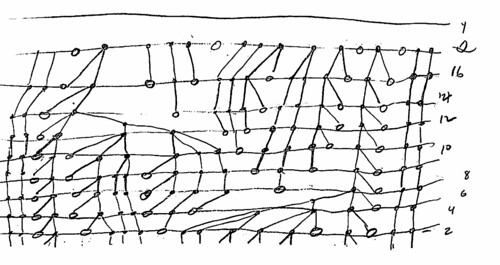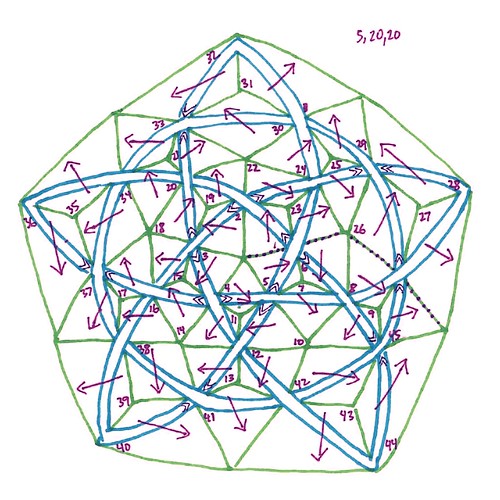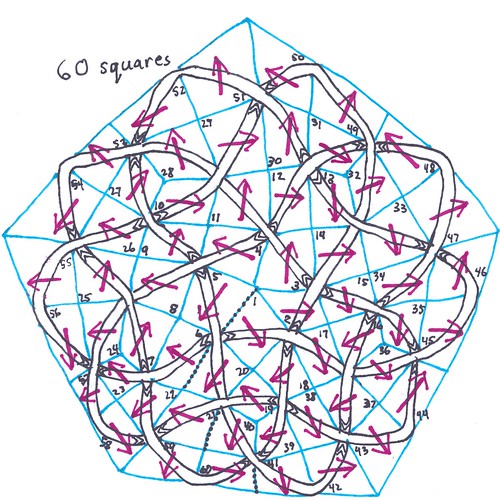Wednesday, December 30, 2009
Ribbed-entrelac hat
I'm making another one now. This one is a tad small, but I ran out of yarn. I decided to use red to finish it off, and I think it looks kind of neat. It's a feature, not a bug!
This hat is created from entrelac squares that are done in ribbing. I used 3 by 3 ribbing because it's quite stretchy and I didn't want to swatch or anything. I figured with the stretchiness the hat would fit my head no matter what.
I'm writing up a pattern for it. More pictures of this on my Flickr account, and more info at my Ravelry page (user name "yarnover").
Thursday, December 17, 2009
Mosaic Knitting Alphabet
Click on the picture below (or the following link) to be taken to the page where the font is hosted on Fonstruct. You can download it for free and use it freely for non-commercial purposes. You should give me credit if you share any patterns that use it, and ask permission if you want to use it for commercial purposes.
If you need help to install your new font, follow this link to FontShop's font installation instructions.
Here's a screen shot of all the characters in the font (click to get bigger sizes). I can't remember, but I think I did all the Western European letters, so there is plenty of accented goodness, but Eastern European alphabets users are likely out of luck. Hey, but there is a Euro symbol!

Here's some knitting done with the font:
Wednesday, December 16, 2009
Illustrating lace knitting
 I posted recently some diagrams I made of Barbara Walker's "Day-flower" lace insertion pattern found in one of her Treasuries stitch collection books.
I posted recently some diagrams I made of Barbara Walker's "Day-flower" lace insertion pattern found in one of her Treasuries stitch collection books.It took a lot of practice and exploration for me to be able to do that latest, most detailed diagram.
About two years ago I was trying to figure out how to illustrate knitting stitch patterns in the old-school way, where it's all hand-drawn, showing each twist and turn of the knitted yarn. I did develop one method, shown here, that's most suitable for lace knitting, and even for knitted lace, where the shaping is done on each row.
There's a whole lot of idealizing and simplifying involved, but this kind of illustration is at least "topologically" accurate.
The key for me was designing and printing a type of graph paper that represents the approximate 3:4 height-to-width ratio of knitted stitches. Then I had to figure out the rather weird things that yarn overs do to the proportions of the knitted loops.
These illustrations show how an ideal knitted fabric would look when projected on a screen, that is, all of the three-dimensional quality of the fabric is lost. There's no information here about whether stitches are knits or purls nor whether the decreases are right- or left-leaning, only where the yarn overs and decreases are, and how the columns (wales) of stitches slant and flow into each other.
Still, they are much more faithful to the look of the knitted fabric than anything I'd been able to do up to that point. I could even knit from them, but I'm weird that way.
Eventually I started to do this on a computer, like the third illustration here. Still, I like the hand drawn ones because of the roughness. You'll see more examples of this kind of diagram in my Flickr set "Knitting Diagrams."
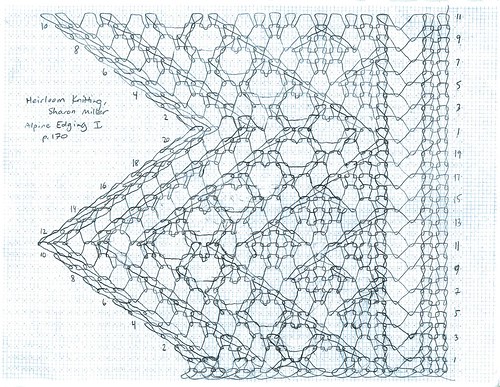
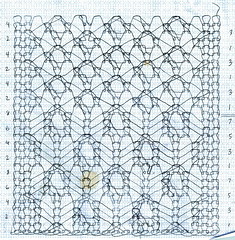
Saturday, December 12, 2009
Lace Twist-Stitch Argyle Pattern: Chart, Directions, Stitch Key
By Kind Request
One of my beloved commenters requested a stitch pattern for the "Lace Twist-Stitch 'Argyle' Pattern" (please, for the love of Pete, think of a better name). I created this pattern a while ago, and knitted it from a rough diagram whose mysterious symbols were known only to me. With this post and the accompanying PDF files (see below) I hope I've given the instructions in a shape that other people can follow.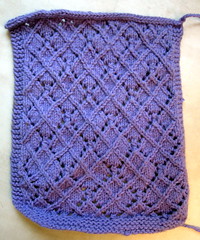 Image by fuzzyjay via Flickr
Image by fuzzyjay via Flickr
Stitch-Pattern Diagram
Close-up Fabric Photograph
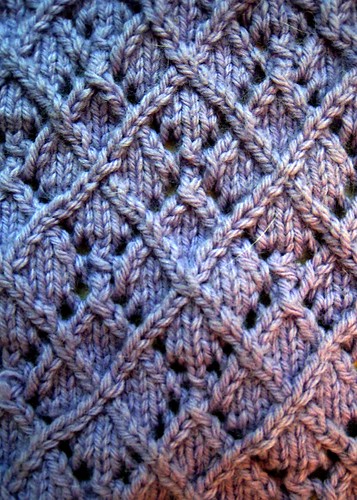
Written-out Directions
Cast on a multiple of 12 stitches plus 1. Stitch count varies. Stitch abbreviations are explained in the stitch key below.Stitch Symbol Key
| Symbol | Stitch name/Stitch operation | Loops used from row below, loops resulting |
| Yarn over (YO). |
0-1
| |
| Yarn over, knit-1-back, yarn over (YO-k1b-YO). | 1-3 | |
| Knit-1-back, yarn over (k1b-YO). | 1-2 | |
| Yarn over, knit-1-back (YO-k1b). | 1-2 | |
| Knit 1 (k1). | 1-1 | |
| Knit 2 together (k2tog). | 2-1 | |
| Slip-Slip-Knit (ssk): Slip 2 as if to knit, insert left needle into front of stitches just slipped, and knit the 2 stitches together. | 2-1 | |
| Slip 1 as if to knit, knit 2-together, pass slipped stitch over the stitch just made (sl1-k2tog-psso). | 3-1 | |
| Right Twist (RT): Knit 2-together, then knit again into the first stitch on the left needle before withdrawing left needle. | 2-2 | |
| Left Twist (LT): Slip 2 as if to knit, return to left needle, Knit 1-back into 2nd stitch from end of left needle, then Knit 2-together through back loops before withdrawing left needle. | 2-2 | |
| Right 3-3 Twist (RT3): Slip 2 as if to knit, then transfer back to left needle by inserting left needle from right to left into both stitches at once and withdrawing the right needle. (Counting from the end of the left needle, the stitch order was 1-2-3, and now it's 2-1-3.) Knit 3 together, yarn over, knit 2 together before withdrawing left needle. | 3-3 | |
| Left 3-3 Twist (LT3): Slip 1 as if to knit, slip 2 as if to knit 2-together. Return the 3 stitches to the left needle, then knit 2-together through the back loops of the 2nd and 3rd stitches on the left needle, yarn over, then knit 3 together through the back loops of all three stitches before withdrawing left needle. | 3-3 | |
| Right-Twist Decrease (RT-dec): Slip 2 as if to knit, then transfer back to left needle by inserting left needle from right to left into both stitches at once and withdrawing the right needle. (Counting from the end of the left needle, the stitch order was 1-2-3, and now it's 2-1-3.) Knit 3 together, then knit 2 together before withdrawing left needle. | 3-2 | |
| Left Twist Decrease (LT-dec): Slip 1 as if to knit, slip 2 as if to knit 2-together. Return the 3 stitches to the left needle, then knit 2 together through the back loops of the 2nd and 3rd stitches on the left needle, then knit 3-together through the back loops of all three stitches before withdrawing left needle. | 3-2 |
PDF is a nice format. I like it.
If you'd like to preview the PDF file (better by far than this web page for printing), follow this link to view a preview on my Posterous blog. And if you'd like to skip a step and directly download the PDF file to look at or print, just download the PDF with diagram, instructions and stitch symbol key to "Lace and Twist-Stitch 'Argyle' pattern." (97k) If you do make anything out of this, I would love to see it. So far, I've made only swatches.Speaking of exotic charting methods
I've got a million of them. Here's one I posted before. Stop me if you've seen these:Monday, December 07, 2009
entrelac pentagram skullcap
It's meant for my little niece or little nephew. When they wear it, it will look more like a hat.
Friday, December 04, 2009
Tuesday, December 01, 2009
dayflower-detail-diagram-repeated
Because I suck at Photoshop, this is iffy, but I can work from it to do a better diagram.
Monday, November 30, 2009
Dayflower Diagram, neatened
I'm really pleased with the way this diagram came out. The little "x"s correspond to missing stitches--rows 4, 6, 12, and 14 have 17 stitches and the rest of the rows have 19. Except for rows 5 and 13, which have 15 stitches, but I didn't want to indicate that.
Not that this diagram shows how the piece looks knitted, but it does point out the structure of the pattern, and points out a way to make the pattern bigger, and, possibly, how to chart an upside-down version of the pattern, which one of my readers has been trying to figure out.
Sunday, November 29, 2009
Double-increase variations
If you diagram it without indicating the way the threads cross, it looks like this.

Without showing how the threads cross, it’s not clear what structure is being created. So, I thought, what are the possible ways to pull three loops through another loop? I have found three essentially different ways (that don't involve twisting the original loop). Two of them have a reverse side that looks different.
1. First is the knit-one-yarnover-knit-one that’s familiar:

You can create this same structure by performing a purl-one-yarnover-purl-one on a reverse-side row.
2. Another is knit-one-yarnover-purl-one. This is a completely reversible structure. It looks the same and is created the same way on both sides of the fabric:

If you do purl-one-yarnover-knit-one, you get the mirror image of the diagram above.
3. A new (?) one is what I tentatively call a knit-squared. You pull a loop through a loop towards you as in knitting, and while keeping the “legs” of the new loop as separate loops, pull the head of the new loop through the old loop towards you again. I am not sure how to efficiently produce it in hand knitting, but the structure is like this:

These are the three different structures (I don’t count the reverse sides of this as different) I’ve found to “disambiguate” the first diagram.
Wednesday, November 25, 2009
"Dayflower" Diagram
All my attempts to diagram this pattern, from Barbara Walker's Lace Knitting book, had failed. This is a drastically simplified version that I was at least able to complete. Now for the neatening-up.
Just sharing my process, folks. It's ugly.
Tuesday, November 17, 2009
most-of-icosidodeca-cabled-entrelac-45-sq
This closed-loop cabled entrelac shape is based on the icosidodecahedron. The cables follow the edges of the Archimedean solid, but not all edges are used.
The goal with this shape was to keep 6 of the pentagons with the triangles that surround them. If this becomes a hat, I'm hoping that you'll be able to see the pentacle at the crown and 5 pentacles around the sides of the hat.
All of the triangles formed by the cables are the same size when knitted, perhaps stretched out a bit when the knitted piece is worn. We shall see.
Sunday, November 15, 2009
Thursday, November 12, 2009
Continuous-loop cable design, Part 2
- Cables can cross where 4 entrelac squares meet at their corners.
- Any regular polygon can be decomposed into (possibly distorted) squares.
- Where polygons so decomposed share an edge, 4 squares meet at their corners.
- Fill in the cables for a tasty continuous-cable treat.
Continuous-loop cable design
The type of knitting I've been complicating lately is a style I call "Continuous Loop Cable Entrelac."
The design goals of this type of knitting are these:
1. produce knitted cables that appear to have no beginning and no end.
2. make these cables with one continuous thread of yarn.
3. minimize grafting.
The way I solved this challenge was to knit entrelac squares that bear diagonal cables. The cables can cross each other where the corners of four squares come together.
The simplest continuous loop would be a simple, uncrossed loop. Such a loop can be created with four entrelac squares that bear diagonal cables.
With a simple loop the beginning and end of the continuous cable have nowhere to hide. It would be possible to graft the beginning and end together, and that's a legitimate choice, but it conflicts with design goal 3.
To avoid grafting the cable itself, the simplest possible loop is a figure-8. With this shape, I can hide the beginning and ending of the cable under a cable crossing.
Figure-8 loop in continuous loop cable entrelac
1. Draw eight squares arranged in a two-by-four rectangle.
2. Indicate the grain of the knitting with a line in each square (this show how the squares are perpendicular to each other, without deciding on the direction of knitting yet.)
3. Draw in a diagonal cable on each square.
4. Draw in how the cables flow from and cross over each other.*
5. Indicate the direction of the cable with chevrons. The cable must start and end under a cable crossing to be able to appear continuous.
6. Indicate the direction of knitting the squares with arrowheads added to the lines in step 2.
7. Number the squares in order of knitting.
8. Diagram each square separately, showing its connections to previous squares.
When it comes time to present the diagram, I usually remove the chevrons I added to the diagram in step 5.
To be continued...
*There are generally two possible ways to do this; I usually have to try both ways to see which would be easier to knit.
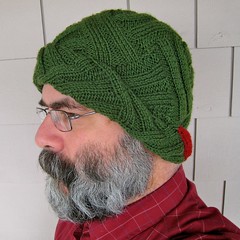
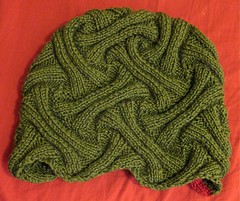
![Reblog this post [with Zemanta]](http://img.zemanta.com/reblog_e.png?x-id=55e2673d-15f2-480b-891e-cbe8133d4c83)
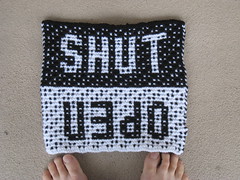
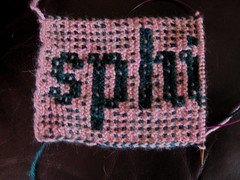
![Reblog this post [with Zemanta]](http://img.zemanta.com/reblog_e.png?x-id=867fc398-6c88-4636-b006-4c7f5ec2d940)
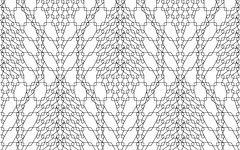



![Reblog this post [with Zemanta]](http://img.zemanta.com/reblog_e.png?x-id=3bb82b3a-3e52-4553-aca7-b76e2047fc5e)

![Reblog this post [with Zemanta]](http://img.zemanta.com/reblog_e.png?x-id=af749ed8-7bc9-44be-98f0-1b741f8a3438)




![Reblog this post [with Zemanta]](http://img.zemanta.com/reblog_e.png?x-id=03011537-5e58-4978-a00a-77451a94a651)
